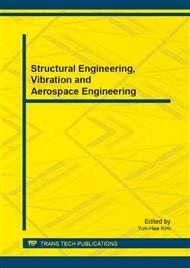p.179
p.183
p.188
p.195
p.200
p.207
p.213
p.217
p.221
Study on Vibration Characteristics of the Vehicles Wing Structure in High Temperature Environment
Abstract:
During the flight of the long-range cruise missiles, aerodynamic heating can cause the temperature of the wing structure, fairing, missile body and other components to rise rapidly, along with serious structural vibrations. The thermal environment generated by aerodynamic heating significantly changes the mechanical properties of the materials and structure, including the elastic modulus, stiffness, and so on. The complex flight maneuver process will also produce high-temperature gradients, which affect the thermal stress field. Both of these impacts significantly affect the characteristics of the missile structures natural vibration. In this paper, thermal vibration joint testing was performed on two different wing structures of a high-speed missile under a thermal environment, and the vibration characteristics of the wing structure (e.g., the natural frequency) at various temperatures were obtained. The experimental results can provide a reliable basis for the safety design of the wing structure of missiles under high-speed thermal vibration conditions.
Info:
Periodical:
Pages:
200-206
Citation:
Online since:
December 2013
Authors:
Price:
Сopyright:
© 2014 Trans Tech Publications Ltd. All Rights Reserved
Share:
Citation:


